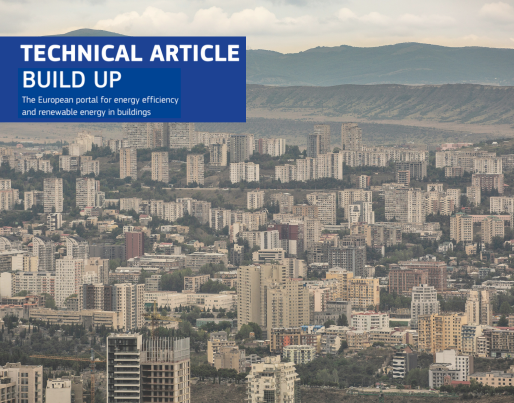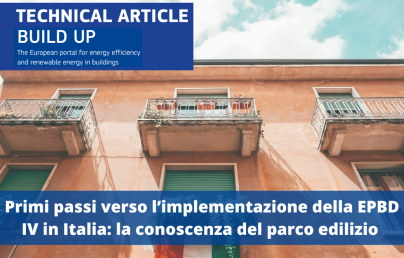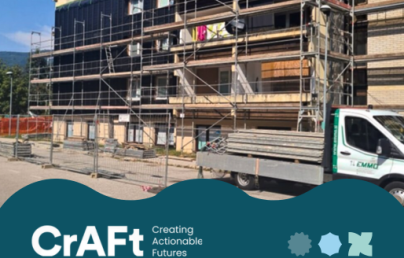
Renovation strategy tool to achieve net zero neighbourhood

Renovation strategy tool to achieve net zero neighbourhood
The renovation wave requires an integrated, participatory, and neighbourhood-specific approach that is customised to the local environment. A digital tool called RESTO (Renovation Strategy Tool) has been developed to help local municipalities automate calculations for comprehensive renovation strategies, by utilising public databases at the neighbourhood level.
Authors
Targo Kalamees, Professor at Tallinn University of Technology | LinkedIn & personal profile
Ergo Pikas, Professor at Tallinn University of Technology | LinkedIn & personal profile
Endrik Arumägi, Senior researcher at Tallinn University of Technology | LinkedIn & personal profile
Jaanus Hallik, Researcher at Tallinn University of Technology | LinkedIn & personal profile
Innar Liiv, Professor at Tallinn University of Technology | LinkedIn & personal profile
Einari Kisel, Head of Partnerships and Strategy at Tallinn University of Technology | LinkedIn & personal profile
(Note: opinions in the articles are of the authors only and do not necessarily reflect the opinion of the EU).
Introduction
The European Green Deal [1] has set ambitious objectives to reduce greenhouse gas emissions and ensure that Europe achieves climate neutrality by 2050. As buildings account for approximately 40-50% of energy consumption, a full decarbonisation of the building stock is needed. However, the proportion of new dwellings completed each year as a percentage of the total EU housing stock remains below 1% [2]. Consequently, deep energy renovation of existing buildings becomes of utmost importance. Achieving decarbonisation of the EU building stock necessitates significant measures across all sectors of society and the economy.
Deep renovation of existing buildings has the potential to save between 60-80% of energy [3, 4]. To drive progress in energy efficiency and foster economic growth, the Commission published a new strategy in 2020 entitled ‘A Renovation Wave for Europe – Greening our buildings, creating jobs, improving lives’ [5]. This strategy aims to increase renovation volumes, such as in Estonia where the average should be five times higher by 2035.
Most member countries establish energy performance targets based on cost-optimal calculations at the individual building level [6, 7, 8, 9]. However, if the long-term goal is only climate or carbon neutrality, it is insufficient to focus solely on renovating individual buildings. The estimation of potential energy savings and carbon emissions resulting from various renovation strategies must be adaptable to encompass larger areas of interest, such as neighbourhoods or districts. This necessitates the adoption of new methods and the consideration of more flexible approaches.
A renovation wave requires an integrated, participatory, and neighbourhood-to-neighbourhood approach that is tailored to local environments. An idea and the initial prototype for a neighbourhood level renovation strategy tool were conceived through a project proposal for the Smart City Challenge 2021 initiated by the FinEst Twins project. The prototype was developed as the Renovation Strategy Tool for Municipalities. Subsequently, the tool has undergone significant enhancements through the support of various projects, namely LIFE IP Buildest, oPEN Lab, and SOFTacademy.
Renovation strategy tool
We have developed a renovation strategy tool which aims to improve the energy and sustainability performance of existing buildings at both the individual building and neighbourhood-municipality levels. A digital tool called RESTO (Renovation Strategy Tool) has been developed to help local municipalities automate calculations for comprehensive renovation strategies. This tool utilises information from national digital databases (including general building data and geometric digital twin models) as well as building typology to estimate the existing conditions and energy performance of buildings. It also assists in developing and assessing renovation measures for each building and creating a renovation strategy for multiple buildings.
The initial data for the tool is sourced from the Estonian Building Registry (EBR) and is linked to digital twin models (Figure 1). These models include 3D representations of all buildings in the existing building stock with a level of detail 2 (LOD2). This combination, along with building-specific reference information in the EBR, allows for a quicker assessment of building energy performance at the district level. However, the availability and quality of data per building in the EBR and LOD models can vary significantly, which can impact the accuracy of calculations. Previous studies in Estonia have shown that methods used to extract and enrich building geometry data from the national building registry [10] and related databases [11] can result in up to a 14% difference in individual building envelope type and their areas. It is recommended that future research focus on improving the accuracy of the data in these databases.
Figure 1: Downscaling data from region to building
The parametric energy calculation routine in the RESTO tool is used to compare different renovation measures and discuss the implications for the renovation industry. The tool utilises a simplified energy calculation model [12] that allows for the efficient assessment of thousands of different renovation measure combinations, Figure 2. The tool uses R software environment for computing and graphics. While the tool may not provide the same level of accuracy as advanced dynamic whole-building simulation tools, it is accurate at the district level. Additionally, the calculation of primary energy demand (EPV) helps improve accuracy by accounting for factors such as solar and internal heat gains. Finally, building-level renovation solutions will be packaged into the neighbourhood level approach, Figure 3.
Figure 2: Building specific solutions.
Figure 3: Packaging the building data for a regional approach.
Application of the renovation strategy tool in the development of positive energy neighbourhoods
In the oPEN Lab project, neighbourhood level building information modelling (BIM) is being utilised along with the RESTO tool for the development of a positive energy neighbourhood (PEN) in Tartu (see Figure 4). According to the European Energy Research Alliance Joint Program on Smart Cities [13] and JPI Urban Europe [14] PEN is defined as an energy-efficient and energy-flexible urban area or group of connected buildings which produce net zero greenhouse gas emissions and actively manage an annual local or regional surplus production of renewable energy. The cost-effectiveness of various renovation solutions was assessed using the net present value (NPV) method. Photovoltaic (PV) panels were employed for the generation of renewable energy. With the use of RESTO, thousands of renovation strategies were generated and compared. The comparison of cost of insulation measures (in accordance with the efficiency first principle) and the cost of onsite electricity generation through PV indicates that onsite electricity generation is more cost-effective when compared to achieving a well-insulated building envelope. However, it should be noted that buildings need to be insulated to minimise heat loss and to achieve a healthy living environment and the area of the roof and external walls alone is insufficient to achieve a PEN. The required area for PV is of a similar magnitude to that of the entire neighbourhood. This shows that RESTO helps in the development of local energy ecosystems, comprising heat and energy donors, and enables the assessment of potential cost savings to support the implementation of essential policies.
Figure 4: Mõisavahe neighbourhood in Tartu (left) and its BIM model in RESTO tool.
Figure 5 Change of NPV and primary energy use of apartment building neighbourhood (left). Cost of investment to building envelope insulation renovation measures and PV panels to achieve nearly zero energy building (nZEB) (right).
Conclusions
We have successfully used a renovation strategy tool to develop positive energy neighbourhood strategies by the deep renovation of high-density high-rise buildings and revitalisation of historic small-town centres. The implementation of the renovation strategy tool effectively decreases the lead time required for the design stage. This encompasses activities such as preliminary designs, renovation concepts, and the development of design criteria at the neighbourhood level.
Achieving net or nearly zero energy performance in the renovation of existing building stock requires an increased focus from a single building to an entire area. Local municipalities play a key role here to support building owners and create suitable prerequisites at the regional level for defending the goal of net zero energy performance. The renovation strategy tool effectively extends the building renovation process to the neighbourhood level and provides services to pertinent key stakeholders.
References
[1] European Commission, “The European Green Deal,” Brussels, 2019. [Online]. Available: https://eur-lex.europa.eu/legal-content/EN/TXT/?uri=COM%3A2019%3A640%3AFIN
[2] OECD, “OECD Affordable Housing Database,” OECD Directorate of Employment, Labour and Social Affairs - Social Policy Division, 2022.
[3] K. Kuusk and T. Kalamees, “nZEB Retrofit of a Concrete Large Panel Apartment Building,” Energy Procedia, vol. 78, pp. 985–990, Nov. 2015, doi: 10.1016/j.egypro.2015.11.038.
[4] J. Hirvonen, J. Jokisalo, J. Heljo, and R. Kosonen, “Towards the EU emissions targets of 2050: optimal energy renovation measures of Finnish apartment buildings,” International Journal of Sustainable Energy, vol. 38, no. 7, pp. 649–672, Aug. 2019, doi: 10.1080/14786451.2018.1559164.
[5] EU COM/2020/662 final, “A Renovation Wave for Europe - greening our buildings, creating jobs, improving lives,” Brussels, 2020.
[6] K. A. Kertsmik, K. Kuusk, K. Lylykangas, and T. Kalamees, “Evaluation of renovation strategies: cost-optimal, CO₂e optimal, or total energy optimal?,” Energy and Buildings, vol. 287, p. 112995, 2023, doi: 10.1016/j.enbuild.2023.112995.

